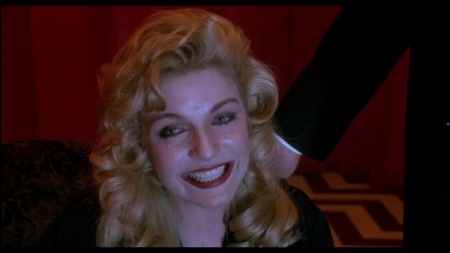
Are we all excited about the new series? We re-watched the last episode of season 2 and the movie, to get us in the mood. Lynch has said the movie is the best way to prepare ourselves for what he has in store. I went LOOKING FOR CLUES.
Fourth shot after the credits sequence ~

UNLAWFUL TO PASS WHEN RED LIGHTS FLASH
Fiona read this one out, which started me thinking it was time for another installment of “Things I Read Off the Screen” — I imagine this is just something that real school buses have, but it feels occult and significant and mysterious here, maybe because school buses aren’t really a thing in the UK. And, given James’ last scene (below), it definitely feels like we’re meant to notice it, and it’ll end up tying the film together.
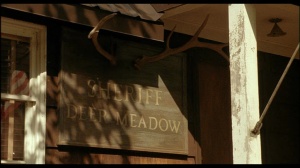
SHERIFF DEER MEADOW
Nice odd phrase. I’ve been enjoying a terrific podcast called Diane which has studied the original series and the movie and the tie-in books and the film, and is now preparing to appreciate and analyse the new shows. You should give it listen. They point out that Deer Meadow, scene of the first BOB murder, is like the anti-Twin Peaks, a town that’s dead, horrible and utterly lacking in positive magic. And the coffee is horrible. So we’re about to meet the anti-Lucy, a sniggering slut, the anti-Andy, a bragging bully, and the anti-Truman, a hulking brute, Sheriff Cable.

In one of the best of the deleted scenes, Chris Isaak beats the hell out of this guy.

Isaak and his buddy Keifer Sutherland (at times evoking Stan Laurel) discover a clue — the letter T under the corpse’s fingernail, which they RIP OFF. Laura Palmer, in the series, will be discovered with an R under her fingernail. In the extra scenes shot for the European release of the original pilot, we are told that the letters were eventually going to spell ROBERT, but this isn’t really canonical. And nobody ever calls BOB “Robert.” It doesn’t suit him, somehow. Still, I like the idea that the name was going to be spelled backwards (TREBOR), since Bob comes from a world where people speak backwards-forwards at the same time.
Based on this movie, I think maybe the word was going to be DIRT backwards. Leland, Laura’s father, who is BOB on some level, during one of his particularly nasty moments tells her there’s a “piece of DIRT” under her nail. This is clearly a reference to her future fate, but the letter R is literally “a piece of DIRT” so that’s why I think that.

HAP’S. With its weeping clown neon and faulty electrics and anti-Peggy Lipton proprietor, Hap’s is the anti-Double R Diner. Unlawful to pass when red light flashes.

SAY HELLO GOODBYE TO JACK.
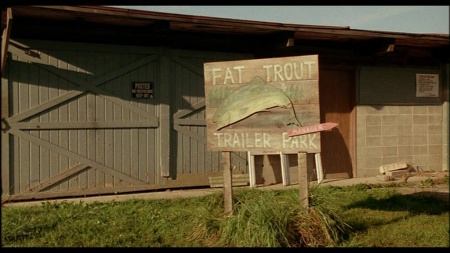
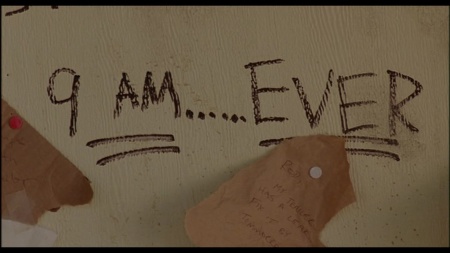
FAT TROUT TRAILER PARK MANAGER
9 AM …… EVER
ROD MY TRAILER HAS A LEAK FIX IT BY TOMORROW
The Fat Trout is a classic liminal space, so it makes sense that the denizens of the Black Lodge have been all over this place, apparently scooting in and out by the telegraph wires. The old lady and her grandson (Lynch’s kid, Sean) used to have a trailer here, and will later appear in Twin Peaks on Laura’s meals-on-wheels route. Eerie enough when they keep to their own red room space, they become uncanny in a whole new way when they trespass in our world or show signs of their presence.
Harry Dean Stanton plays Carl Rodd, who will be back in the new series. I like that one of his… tenants?… thinks his name is “Rod.” So they think they’re calling him by his first name when they’re really calling him by his last name. They’re on different planes of familiarity without realising it. I think I’d be the same way if I met Harry Dean Stanton, because I would want to love and admire him and he would think I am an asshole.


kcoR s’teL
Let’s Rock
This is something the man from another place says in the series — part of the reason TP:FWWM arguably doesn’t stand up as an independent work away from the series is that these things are very satisfying to note, but you have to look outside the movie for them. There aren’t many clues IN the movie which help you feel you’re making headway with its mysteries. But I’ve given up letting that bother me.
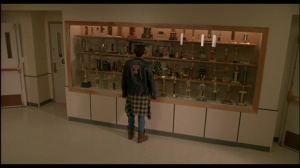
T
Bobby Briggs has a T on his back! He must be involved in the Theresa Banks case! But this does seem like one of the few red herrings. We can’t get excited every time we see a letter T… can we?
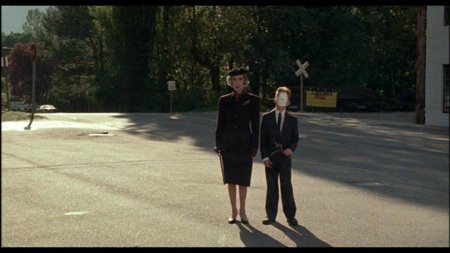
X
Xs, however, are always exciting. This is a direct appearance by red lodge characters in our reality, so the universal symbol for the unknown seems wholly appropriate. If I had the Blu-ray maybe I could tell you what that small lettering says. It might be the key to everything.
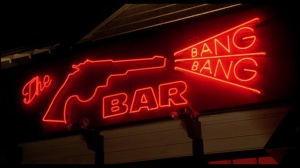
The BANG BANG BAR
An exterior featured in one of the trailers for the new series, so it’ll feature again. Under new management, I presume. Unlawful to pass when red light flashes.

TREAT HIM RIGHT
This one is just kind of funny. But it comes in a very fraught scene, which includes flashbacks which help establish Leland’s motivation for murder ~
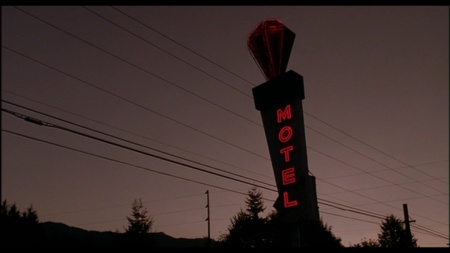
MOTEL
Unlawful to pass when red light flashes. The movie complicates our understanding of Leland’s guilt. In the series, it’s possible to believe that he’s an innocent man invaded by an alien force (BOB, the double-denim demon). In the movie, we clearly see Leland as Leland, plotting and remembering and in full knowledge of his guilt. It puts me in mind of a passage from The Strange Case of Dr. Jekyll and Mr. Hyde (an ur-text for all divided-consciousness horror tales) where Jekyll complains that, deep into his experiment in duality, he was often wholly Hyde but never wholly Jekyll…
Note the presence of those sinister WIRES again.
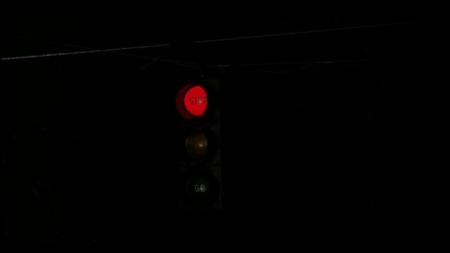
STOP
What the critics at the time didn’t notice (along with Sheryl Lee’s moving and bizarre and fearless performance) but which the Diane podcast is great at spotting, is that the movie takes familiar recurring images from the show like the ceiling fan at the Palmer residence and this set of overhanging traffic lights, and imbues them with new and more powerful meaning. This turns out to be the setting for Laura and James’ last love scene. James will watch her go, then wait for the light to turn red before revving up and roaring off…
Unlawful to pass when red light flashes.






